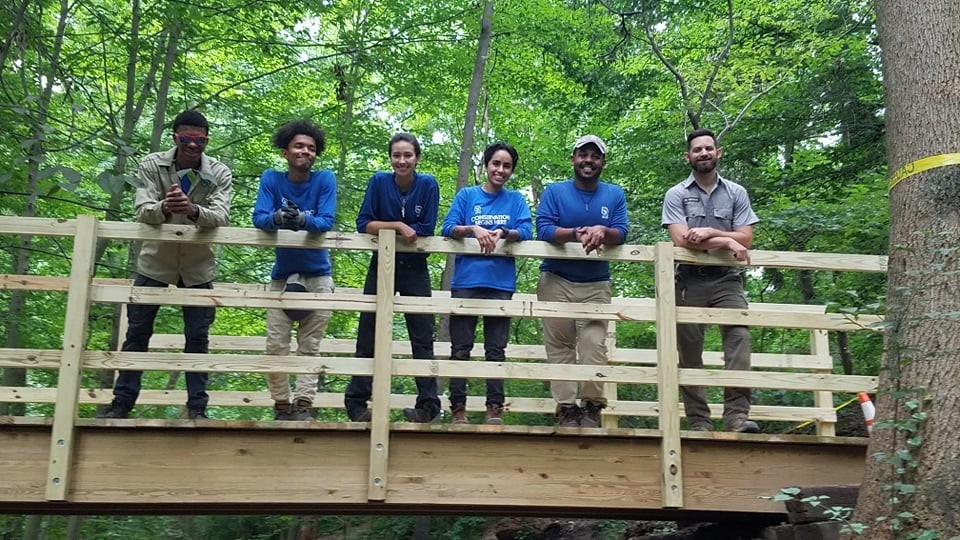Last updated: November 17, 2021
Article
SCA's Battery Kemble Crew Experiences Community, Conservation, and Connection at Rock Creek Park

NPS Photo
The name for the crew refers to the Battery Kemble Park, where the bridge was being repaired. It was part of the Civil War Defenses of Washington (also called Fort Circle) and was completed in 1861. Most of the Army and Navy guns were made here during the Civil War. The park got its name from the former superintendent of West Point Foundry, Gouverneur Kemble of Cold Spring, New York.
It was a small, but mighty team of five: Crew leader Leopold Sawyers and four crew members. Maxwell Newman also provided guidance as a former SCA member and current National Park Service maintenance worker. It was the first time any of them had built a bridge before. The original bridge was made from cables. Maxwell explained that “Once the bridge is demoed, they do the rock enforcement, focusing on repairing the abutment. A lot of it was surveying and figuring out our bridge height. The old bridge was not level; this is level. There is a slight arch in the bridge. That is the type of material we bought, and [it] is designed to actually span long distances without support in the middle, so it comes with a pre-loaded arch in it.”
For them, working on the crew was more than just building the bridge; it was the opportunity to be around like-minded people who were connected by the love of conservation, and the friendships that were made throughout the summer. We asked them to spell-out “SCA,” which was a great team-building exercise, and they went through several variations, especially on the letter “A.”

NPS Photo

NPS Photo
On the impact this crew has had on the crew members and the park, Maxwell reflected, “It’s a great opportunity to learn about the parks and not just about trail work but the natural resources that we have here in general. This crew in particular has been a blast.” He noted that when there is a building project and the outcome is tangible, this can spark energy and enthusiasm within the group.
Crew member Seori Stephens explained that she got her start in conservation in high school. While many of her friends had taken internships in offices, she wanted one that would allow her to work outside. She had gone to a magnet school where they had an environmental program that took the students on field trips every two weeks, whether they were hikes, or other outdoor activities. From a Google search, she found SCA and has loved being part of these crews ever since. “We visited a lot of companies in DC that were working for the environment. My family also really liked to hike, so I always really liked being outside, and I cared about the environment,” she recalled.
When it comes to representation in the conservation field, we know this has been a challenge and efforts have been made to make parks and green spaces more accessible to everyone. Leopold, the Crew Leader, did not initially realize conservation was a viable option for him. “I always knew I wanted to work outdoors, but I really didn’t see myself as someone who could go out and lead crews, travel, and learn all these different skills. It really broadened my understanding of what conservation work is.”

Photo Courtesy of Student Conservation Association
Watch this video of some of the SCA Battery Kemble crew members, crew leader, and NPS staff member talk about the impact this crew had on them.
- Duration:
- 2 minutes, 40 seconds
Over the summer, the Student Conservation Association (SCA) and the National Park Service Youth Programs Division were excited to visit SCA’s Battery Kemble crew at Rock Creek Park on July 29, 2021 to check out the hard work they had been working on for the past seven weeks. This crew worked for ten weeks on the removal of a deteriorated bridge and building of a new 30-foot bridge to provide easier and safer access for trail users. Crew members and crew leaders were interviewed for a feature spotlight.
If you have any questions about NPS Youth and Young Adult Programs, please e-mail us and follow us on Facebook, Instagram, and Twitter @npsyouth and use #npsyouth to share your experience with us! Visit our page to find the many opportunities for youth and young adults to get involved with our parks.
